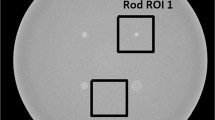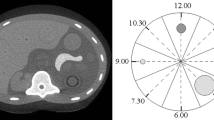Abstract
Objectives
To evaluate the impact of model-based iterative reconstruction (MBIR) on image quality and low-contrast lesion detection compared with filtered back projection (FBP) in abdominal computed tomography (CT) of simulated medium and large patients at different tube voltages.
Methods
A phantom with 45 hypoattenuating lesions was placed in two water containers and scanned at 70, 80, 100, and 120 kVp. The 120-kVp protocol served as reference, and the volume CT dose index (CTDIvol) was kept constant for all protocols. The datasets were reconstructed with MBIR and FBP. Image noise and contrast-to-noise-ratio (CNR) were assessed. Low-contrast lesion detectability was evaluated by 12 radiologists.
Results
MBIR decreased the image noise by 24% and 27%, and increased the CNR by 30% and 29% for the medium and large phantoms, respectively. Lower tube voltages increased the CNR by 58%, 46%, and 16% at 70, 80, and 100 kVp, respectively, compared with 120 kVp in the medium phantom and by 9%, 18% and 12% in the large phantom. No significant difference in lesion detection rate was observed (medium: 79-82%; large: 57-65%; P > 0.37).
Conclusions
Although MBIR improved quantitative image quality compared with FBP, it did not result in increased low-contrast lesion detection in abdominal CT at different tube voltages in simulated medium and large patients.
Key Points
• MBIR improved quantitative image quality but not lesion detection compared with FBP.
• Increased CNR by low tube voltages did not improve lesion detection.
• Changes in image noise and CNR do not directly influence diagnostic accuracy.


Similar content being viewed by others
Change history
29 September 2017
An erratum to this article has been published.
References
Tirumani SH, Kim KW, Nishino M, Howard SA, Krajewski KM, Jagannathan JP et al (2014) Update on the role of imaging in management of metastatic colorectal cancer. Radiographics 34:1908–1928
Kanal KM, Chung JH, Wang J, Bhargava P, Kohr JR, Shuman WP et al (2011) Image noise and liver lesion detection with MDCT: a phantom study. AJR Am J Roentgenol 197:437–441
Goenka AH, Herts BR, Obuchowski NA, Primak AN, Dong F, Karim W et al (2014) Effect of reduced radiation exposure and iterative reconstruction on detection of low-contrast low-attenuation lesions in an anthropomorphic liver phantom: an 18-reader study. Radiology 272:154–163
Deak Z, Grimm JM, Treitl M, Geyer LL, Linsenmaier U, Korner M et al (2013) Filtered back projection, adaptive statistical iterative reconstruction, and a model-based iterative reconstruction in abdominal CT: an experimental linical study. Radiology 266:197–206
Aurumskjold ML, Ydstrom K, Tingberg A, Soderberg M (2017) Improvements to image quality using hybrid and model-based iterative reconstructions: a phantom study. Acta Radiol 58:53–61
Holmquist F, Nyman U, Siemund R, Geijer M, Soderberg M (2016) Impact of iterative reconstructions on image noise and low-contrast object detection in low kVp simulated abdominal CT: a phantom study. Acta Radiol 57:1079–1088
Kim JH, Choo KS, Moon TY, Lee JW, Jeon UB, Kim TU et al (2016) Comparison of the image qualities of filtered back-projection, adaptive statistical iterative reconstruction, and model-based iterative reconstruction for CT venography at 80 kVp. Eur Radiol 26:2055–2063
Song JS, Lee JM, Sohn JY, Yoon JH, Han JK, Choi BI (2015) Hybrid iterative reconstruction technique for liver CT scans for image noise reduction and image quality improvement: evaluation of the optimal iterative reconstruction strengths. Radiol Med 120:259–267
Kalva SP, Sahani DV, Hahn PF, Saini S (2006) Using the K-edge to improve contrast conspicuity and to lower radiation dose with a 16-MDCT: a phantom and human study. J Comput Assist Tomogr 30:391–397
Schindera ST, Nelson RC, Mukundan S Jr, Paulson EK, Jaffe TA, Miller CM et al (2008) Hypervascular liver tumors: low tube voltage, high tube current multi-detector row CT for enhanced detection—phantom study. Radiology 246:125–132
Robinson E, Babb J, Chandarana H, Macari M (2010) Dual source dual energy MDCT: comparison of 80 kVp and weighted average 120 kVp data for conspicuity of hypo-vascular liver metastases. Invest Radiol 45:413–418
Mieville FA, Gudinchet F, Brunelle F, Bochud FO, Verdun FR (2013) Iterative reconstruction methods in two different MDCT scanners: physical metrics and 4-alternative forced-choice detectability experiments—a phantom approach. Phys Med 29:99–110
Yu MH, Lee JM, Yoon JH, Baek JH, Han JK, Choi BI et al (2013) Low tube voltage intermediate tube current liver MDCT: sinogram-affirmed iterative reconstruction algorithm for detection of hypervascular hepatocellular carcinoma. AJR Am J Roentgenol 201:23–32
Schindera ST, Odedra D, Raza SA, Kim TK, Jang HJ, Szucs-Farkas Z et al (2013) Iterative reconstruction algorithm for CT: can radiation dose be decreased while low-contrast detectability is preserved? Radiology 269:511–518
Schindera ST, Odedra D, Mercer D, Thipphavong S, Chou P, Szucs-Farkas Z et al (2014) Hybrid iterative reconstruction technique for abdominal CT protocols in obese patients: assessment of image quality, radiation dose, and low-contrast detectability in a phantom. AJR Am J Roentgenol 202:W146–W152
Chang W, Lee JM, Lee K, Yoon JH, Yu MH, Han JK et al (2013) Assessment of a model-based, iterative reconstruction algorithm (MBIR) regarding image quality and dose reduction in liver computed tomography. Invest Radiol 48:598–606
Volders D, Bols A, Haspeslagh M, Coenegrachts K (2013) Model-based iterative reconstruction and adaptive statistical iterative reconstruction techniques in abdominal CT: comparison of image quality in the detection of colorectal liver metastases. Radiology 269:469–474
Fontarensky M, Alfidja A, Perignon R, Schoenig A, Perrier C, Mulliez A et al (2015) Reduced radiation dose with model-based iterative reconstruction versus standard dose with adaptive statistical iterative reconstruction in abdominal CT for diagnosis of acute renal colic. Radiology 276:156–166
Solomon J, Mileto A, Ramirez-Giraldo JC, Samei E (2015) Diagnostic performance of an advanced modeled iterative reconstruction algorithm for low-contrast detectability with a third-generation dual-source multidetector CT scanner: potential for radiation dose reduction in a multireader study. Radiology 275:735–745
Menke J (2005) Comparison of different body size parameters for individual dose adaptation in body CT of adults. Radiology 236:565–571
Gordic S, Morsbach F, Schmidt B, Allmendinger T, Flohr T, Husarik D et al (2014) Ultralow-dose chest computed tomography for pulmonary nodule detection: first performance evaluation of single energy scanning with spectral shaping. Invest Radiol 49:465–473
Gordic S, Desbiolles L, Stolzmann P, Gantner L, Leschka S, Husarik DB et al (2014) Advanced modelled iterative reconstruction for abdominal CT: qualitative and quantitative evaluation. Clin Radiol 69:e497–e504
Botsikas D, Stefanelli S, Boudabbous S, Toso S, Becker CD, Montet X (2014) Model-based iterative reconstruction versus adaptive statistical iterative reconstruction in low-dose abdominal CT for urolithiasis. AJR Am J Roentgenol 203:336–340
Patino M, Fuentes JM, Hayano K, Kambadakone AR, Uyeda JW, Sahani DV (2015) A quantitative comparison of noise reduction across five commercial (hybrid and model-based) iterative reconstruction techniques: an anthropomorphic phantom study. AJR Am J Roentgenol 204:W176–W183
Scholtz JE, Wichmann JL, Husers K, Albrecht MH, Beeres M, Bauer RW et al (2016) Third-generation dual-source CT of the neck using automated tube voltage adaptation in combination with advanced modeled iterative reconstruction: evaluation of image quality and radiation dose. Eur Radiol 26:2623–2631
Schaller F, Sedlmair M, Raupach R, Uder M, Lell M (2016) Noise reduction in abdominal computed tomography applying iterative reconstruction (ADMIRE). Acad Radiol 23:1230–1238
de Margerie-Mellon C, de Bazelaire C, Montlahuc C, Lambert J, Martineau A, Coulon P et al (2016) Reducing radiation dose at chest CT: comparison among model-based type iterative reconstruction, hybrid iterative reconstruction, and filtered back projection. Acad Radiol 23:1246–1254
Park HJ, Lee JM, Park SB, Lee JB, Jeong YK, Yoon JH (2016) Comparison of knowledge-based iterative model reconstruction and hybrid reconstruction techniques for liver CT evaluation of hypervascular hepatocellular carcinoma. J Comput Assist Tomogr 40:863–871
Holm J, Loizou L, Albiin N, Kartalis N, Leidner B, Sundin A (2012) Low tube voltage CT for improved detection of pancreatic cancer: detection threshold for small, simulated lesions. BMC Med Imaging 12:20
Hernandez-Giron I, Calzado A, Geleijns J, Joemai RM, Veldkamp WJ (2015) Low contrast detectability performance of model observers based on CT phantom images: kVp influence. Phys Med 31:798–807
Marin D, Nelson RC, Barnhart H, Schindera ST, Ho LM, Jaffe TA et al (2010) Detection of pancreatic tumors, image quality, and radiation dose during the pancreatic parenchymal phase: effect of a low-tube-voltage, high-tube-current CT technique—preliminary results. Radiology 256:450–459
Lv P, Liu J, Zhang R, Jia Y, Gao J (2015) Combined use of automatic tube voltage selection and current modulation with iterative reconstruction for CT evaluation of small hypervascular hepatocellular carcinomas: effect on lesion conspicuity and image quality. Korean J Radiol 16:531–540
Bae KT (2010) Intravenous contrast medium administration and scan timing at CT: considerations and approaches. Radiology 256:32–61
Dodge CT, Tamm EP, Cody DD, Liu X, Jensen CT, Wei W et al (2016) Performance evaluation of iterative reconstruction algorithms for achieving CT radiation dose reduction—a phantom study. J Appl Clin Med Phys 17:5709
Fletcher JG, Yu L, Li Z, Manduca A, Blezek DJ, Hough DM et al (2015) Observer performance in the detection and classification of malignant hepatic nodules and masses with CT image-space denoising and iterative reconstruction. Radiology 276:465–478
Tseng HW, Fan J, Kupinski MA, Sainath P, Hsieh J (2014) Assessing image quality and dose reduction of a new X-ray computed tomography iterative reconstruction algorithm using model observers. Med Phys 41:071910
Ott JG, Ba A, Racine D, Viry A, Bochud FO, Verdun FR (2016) Assessment of low contrast detection in CT using model observers: developing a clinically-relevant tool for characterising adaptive statistical and model-based iterative reconstruction. Z Med Phys. doi:10.1016/j.zemedi.2016.04.002
Racine D, Ryckx N, Ba A, Ott JG, Bochud FO, Verdun FR (2016) Benchmarking of CT for patient exposure optimisation. Radiat Prot Dosimetry 169:78–83
Author information
Authors and Affiliations
Corresponding author
Ethics declarations
Guarantor
The scientific guarantor of this publication is Sebastian T. Schindera.
Conflict of interest
Sebastian T. Schindera received a research grant by Siemens Healthcare and Bayer Healthcare
Funding
The authors state that this work has not received any funding.
Statistics and biometry
No complex statistical methods were necessary for this paper.
Ethical approval
Institutional Review Board approval was not required because of the design as a phantom study.
Methodology
• prospective
• experimental
• performed at one institution
Additional information
The original version of this article was revised: The name of the 12th author has been corrected to Luigia D’Errico.
An erratum to this article is available at https://doi.org/10.1007/s00330-017-4985-7.
Rights and permissions
About this article
Cite this article
Euler, A., Stieltjes, B., Szucs-Farkas, Z. et al. Impact of model-based iterative reconstruction on low-contrast lesion detection and image quality in abdominal CT: a 12-reader-based comparative phantom study with filtered back projection at different tube voltages. Eur Radiol 27, 5252–5259 (2017). https://doi.org/10.1007/s00330-017-4825-9
Received:
Revised:
Accepted:
Published:
Issue Date:
DOI: https://doi.org/10.1007/s00330-017-4825-9




